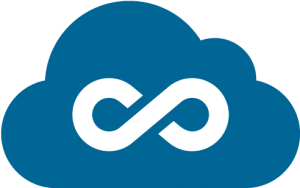 CLOUD
CLOUD
 CLOUD
CLOUD
 CLOUD
CLOUD
In the beginning, all software was open. The first programs were written within the collaborative world of academia, where research is openly shared for the advancement of all. It was only when software became big business that the practice of sharing code became seen as counter to corporate goals.
But open source never went away. Thanks to Red Hat Enterprise Linux and other projects, open-source became embedded into enterprise software. And with the rise of cloud it has become increasingly prominent. Red Hat Inc.’s recent “State of Enterprise Open Source” report shows that 90% of information technology leaders use open-source products.
That collaboration and capitalism aren’t mutually exclusive should come as no surprise as traditional business leaders move into the digital realm where end user devices reign. As open-source and enterprise end users unite, theCUBE takes a look at the latest iteration of corporate investment in open source projects, speaking with analysts, cloud executives and investors regarding the role of end user input as the developer community paves hybrid paths to the new edge.
There are numerous factors driving fresh involvement in open-source by traditional businesses, starting with cloud computing. Prior to 2020 cloud was still seen as a “nice to have” by organizations leery of the costs and complications of moving data out of the safety of the data center.
Then came the COVID-19 pandemic shut-downs. Small, medium and big companies alike scrambled to adapt as operations went remote. Collaboration through the use of open-source code was the only way developers could keep up with the rapid demand for new applications.
“Open source moves at the rate and pace of global innovation,” Hillery Hunter, vice president and chief technology officer of IBM Cloud at IBM, said during an interview at this year’s Red Hat Summit. “There’s been innovation on everything from climate change to musical applications, to things that are the fundamentals of major enterprise — mission-critical workloads that have happened as everyone is adopting cloud and open source faster.”
Open source also reduces entry costs, making it attractive for companies in a hurry to get their digital operations up and running.
“It’s an excellent way for companies to get great innovation at a lower cost,” said Mark Potts, managing director and global lead for Accenture’s IBM and Red Hat alliance. “We saw this with Java, Linux and chip companies open-sourcing their designs to get more adoption and reduce manufacturing costs.”
An undeniable factor in open source’s mainstream appeal has been the widespread use of open-source container orchestration system Kubernetes.
Before Kubernetes became a top influencer of the open-source world, projects flew under the mainstream radar. While Linux was widely used in enterprise thanks to IBM’s $1 billion investment in 2001, open source was seen as the domain of cloud native companies and developers who contributed in their spare time.
Then cloud adoption became a business imperative, and with the rise of cloud came the rise of open source. Containers, which grew out of a Linux kernel process isolation construct, made cloud deployment possible by packaging code for easy transportation. And coordinating containers is Kubernetes’ mission statement. Basically, the technology enabled the fast and agile workflow that has come to define the modern business world.
“An entirely new ecosystem is being built around Kubernetes,” according to Potts. “This will bring more innovation to our clients and the industry. It won’t be ‘born on the cloud.’ It will be ‘born on Kubernetes and run anywhere’ in the future,” he said.
But will enterprise companies commit as fully to the open-source ecosystem as IBM, which invested another $34 billion with the acquisition of Red Hat in 2019?
“IBM was an early supporter of Linux and had a 20-year partnership with Red Hat, including hybrid cloud initiatives, even before the acquisition,” said Potts, who sees the move as “just another example of how open source can be an enterprise player and scale.”
“There have been a fair few acquisitions over the past few years as open source evolved to become a key building block of the modern enterprise,” said Ollie O’Donoghue, senior analyst at PAC, a teknowlogy Group company. He pointed out that while Red Hat is high profile, it is not the only open-source company to have been snapped up by a more traditional corporation.
In 2018, Salesforce.com Inc. purchased MuleSoft LLC for $6.5 billion, and way back in 2009 Oracle Corp. acquired popular open-source database MySQL as part of the Sun Microsystems Inc. deal. Although Oracle wasn’t considered an advocate of open source at the time, fears that the company would kill the project were ultimately proved unfounded. In the end, it was Sun that fizzled, while MySQL is now the most popular database amongst professional developers.
Oracle is taking notice: With its purchase of query database accelerator HeatWave, the one-time fierce proponent of proprietary software is now investing more in its open-source assets.
In April this year, Microsoft purchased open-source company Kinvolk GmbH, admitting plans “to learn from the Kinvolk team’s great track record in starting, building and nurturing open-source community projects.”
“We strongly believe that most of the hard (and, by that we mean interesting) problems of today will take a team or the whole industry to solve. This means we all need to be trustworthy and (corporately) self-aware participants in open source,” Sarah Novotny, open-source lead at Microsoft Azure, wrote in her blog post “4 Open Source Lessons for 2021.”
Open source changes the way software is discovered, tried, collaborated on and improved, according to Casbar Wang, vice president of Sapphire Ventures Inc.
“Done right, a fundamentally decentralized model like open source is a better reflection of the voice of the end user, leading to better end-user experience,” Wang told theCUBE.
 Commercial software and open source cohabitate
Commercial software and open source cohabitateAcquiring an open-source company is not the only way of supporting the ecosystem.
“Traditional technology companies should actively embrace open-source software and strive to keep the software open source,” Daniel Lahl, global vice president of product marketing at SAP SE, told theCUBE.
SAP has done this on projects with Cloud Foundry and the Cloud Native Computing Foundation, and Lahl believes that “working within the community of open source to make it better and more widely adopted is far better for open source than a single technology company controlling the open-source governance and community.”
Many big IT service providers partner with open-source players, working in tandem to push initiatives forward, according to O’Donoghue. “This is often a very effective model,” he said.
Increasingly, companies are supporting both commercial and open-source community editions of the same product, Wang pointed out.
“Two things can be true at the same time: The full benefits of the open-source commercial model will not be replicated, and we can expect the open source we know today to continue to evolve and thrive, while non-open source companies can take a page from the commercial open source playbook,” he wrote in a blog post.
An example comes from SAP, which acquired open-source graph database OrientDB along with Callidus Software Inc. in 2018. The company supports the commercial edition of OrientDB as a traditional product while also providing an open-source community edition.
 Open source standards enable hybrid cloud
Open source standards enable hybrid cloud“One of the most powerful benefits of open-source technologies is giving enterprises a consistent and standardized toolset to do business with,” O’Donoghue said.
This ability to provide a consistent underlying layer is part of the popularity of Kubernetes as hybrid becomes the default cloud model for companies with extensive legacy infrastructure.
“A digitally native company founded in the 2010s has little reason to go hybrid. However, for a Fortune 500 or Global 2000 enterprise that’s going through digital transformation, hybrid cloud is likely the permanent state,” Sapphire Ventures’ Wang said. “It’s pretty difficult to rip and replace on-prem solutions. Larger enterprises, especially those that have been around for centuries now, will struggle with the process. It will take them a lot of time to move to the cloud and, in some cases, is more risk than reward.”
Recent announcements by Red Hat that the company is focusing on edge deployments means enterprises have a degree of standardization with their IT core-to-edge computing and IoT devices, according to O’Donoghue.
“There is a huge amount of innovation going on among the cloud and IT giants to help enterprises orchestrate and operate hybrid cloud environments and build an infrastructure model that matches the best solution to the challenge,” Potts said.
The hybrid cloud here to stay, according to consensus by analysts and industry experts contacted by theCUBE. And with it, open-source enterprise use cases will continue to rise.
“There is a strong ecosystem play for open-source solutions as businesses and organizations become more connected internally and externally,” O’Donoghue said. “Open source offers that critical shared middle ground for the teams that are working to knit these different pieces together. So it’s likely to be an exciting and dynamic market over the next few years.”
THANK YOU